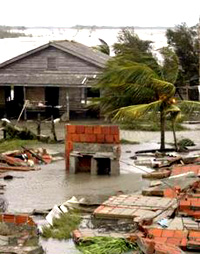 |
Part of the kitchen is
all what is left of a house in Punta de
Carta, in the Cuban province of Pinar del
Rio, September 14, 2004. Hurricane Ivan brushed Cuba's western tip on
Monday, causing limited damage to houses but the flooding of
coastal
areas.
| |
Hundreds of thousands of people along the U.S. coast from New Orleans
to northwest Florida were told to leave their homes on September 14 as
deadly Hurricane Ivan roared into the Gulf of Mexico after grazing western
Cuba.
Ivan, one of the most powerful Atlantic hurricanes on record, killed at
least 68 people on a weeklong rampage through the Caribbean as it
caused widespread damage in Grenada, Jamaica and the Cayman Islands.
It ripped off roofs and downed trees and power lines when it roared
past Cuba on Monday night, but the island was spared a direct hit and
there were no reported casualties.
Ivan, carrying winds of up to 140 mph, threatened an area of several
hundred miles from the sugary beaches of the Florida Panhandle west
through coastal Alabama and Mississippi to the flood-prone, historic jazz
city of New Orleans, where officials told residents to get out.
"This is a very dangerous storm," said Mayor Ray Nagin, adding that
Ivan's hurricane-force winds extended so far out that the city could
suffer even if it struck 100 miles away. "We're asking people to consider
leaving the city if you have the wherewithal to do that."
Metropolitan New Orleans has a population of about 1.5 million.
Storm-weary Florida authorities, preparing for a possible third
hurricane strike in just over a month, told about 543,000 people to
evacuate mobile homes and flood-prone coastal areas in at least 10
counties in the western Panhandle.
Oil companies plucked thousands of workers from offshore rigs and shut
down some refineries and offshore rigs in the Gulf of Mexico, home of
about a quarter of U.S. oil and gas output. Ivan's menacing presence
pushed up world oil prices, which rose by more than 50 cents a barrel.
The hurricane was forecast to thunder into the Gulf coast late on
Wednesday or early on Thursday, bringing storm surge flooding of up to 16
feet above normal tide levels.
It weakened slightly as it moved north but was still a dangerous
Category 4 storm on the five-step hurricane intensity scale.
Its top winds were down from a peak of 165 mph on Saturday, when the
U.S. National Hurricane Center said it was the sixth-strongest Atlantic
hurricane on record. But its hurricane-force winds extended out 105
miles.
(Agencies) |
來勢洶洶的颶風(fēng)“伊萬”在襲擊古巴西部后,又咆哮著沖入了墨西哥灣。9月14日,幾十萬居住在從新奧爾良到佛羅里達(dá)西北部海岸沿線的美國居民接到預(yù)警后被迫離開家園。
“伊萬”是有記載的最強(qiáng)勁的大西洋颶風(fēng)之一。這場颶風(fēng)在加勒比海肆虐的一個(gè)星期內(nèi),造成至少68人死亡,同時(shí)在格林納達(dá)、牙買加和開曼群島也造成了大范圍破壞。
周一晚上,颶風(fēng)呼嘯著掠過古巴,所到之處屋頂被掀翻,樹木被推倒,電線被切斷。所幸該島國免遭颶風(fēng)的正面襲擊。目前還沒有有關(guān)人員傷亡的報(bào)道。
目前颶風(fēng)“伊萬”正以每小時(shí)140英里的速度前進(jìn),威脅著幅員幾百英里的地區(qū)。“伊萬”從佛羅里達(dá)州狹長地帶的“甜蜜海灘”向西推進(jìn),橫穿阿拉巴馬州和密西西比州沿海一帶,直到洪水易發(fā)區(qū)、歷史上著名的爵士樂城市新奧爾良,該市官員告誡居民(盡快)撤離。
(新奧爾良)市長雷·納金說:“這是一場極其危險(xiǎn)的風(fēng)暴。”他還補(bǔ)充說“伊萬”颶風(fēng)的風(fēng)力可以波及到很遠(yuǎn)的地區(qū),即使它在襲擊離城市100英里的地區(qū)時(shí),新奧爾良也會(huì)遭到破壞。“我們建議市民如果有足夠的資金,應(yīng)該趕快離開這座城市。”
新奧爾良約有150萬人口。
佛羅里達(dá)當(dāng)局已經(jīng)被連日的暴風(fēng)雨折騰得疲憊不堪。他們正在為短短一個(gè)多月內(nèi)可能發(fā)生的第三次颶風(fēng)襲擊做準(zhǔn)備,通知位于佛羅里達(dá)狹長地帶西部至少10個(gè)縣的54.3萬人口撤離可移動(dòng)式房屋和沿海洪水易發(fā)區(qū)。
石油公司從海上鉆井臺(tái)撤回了數(shù)千名工人,并關(guān)閉了位于墨西哥灣的一些煉油廠和海上鉆井。墨西哥灣的石油和天然氣的產(chǎn)量占到美國總產(chǎn)量的四分之一。颶風(fēng)“伊萬”的威脅使得全世界石油價(jià)格上漲,每桶石油的價(jià)格上漲了50多美分。
這場颶風(fēng)預(yù)計(jì)將在周三晚或周四早上席卷墨西哥灣沿岸,隨之而來的暴風(fēng)雨將使水位超出正常潮汐水位16英尺。
目前,颶風(fēng)仍在向北移動(dòng),風(fēng)勢逐漸減弱。但是在衡量颶風(fēng)強(qiáng)度的五級指標(biāo)中,仍處于危險(xiǎn)的四級風(fēng)暴強(qiáng)度。
上周六,颶風(fēng)“伊萬”中勢頭最強(qiáng)勁的一股風(fēng)力開始回落,它的最高時(shí)速曾達(dá)到每小時(shí)165英里。美國國家颶風(fēng)中心表示,這是有史以來風(fēng)力第六強(qiáng)的大西洋颶風(fēng),但是其風(fēng)力波及到方圓105英里的區(qū)域。
(中國日報(bào)網(wǎng)站譯) |
